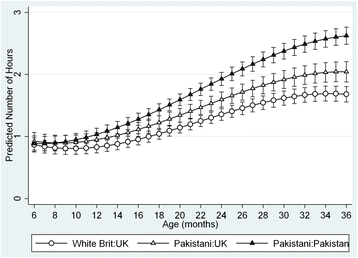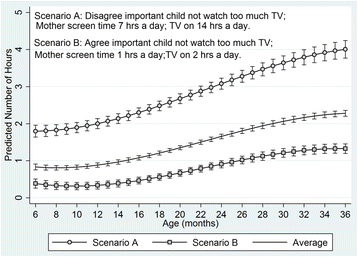Prevalence, trajectories, and determinants of television viewing time in an ethnically diverse sample of young children from the UK
- PMID: 28683801
- PMCID: PMC5501260
- DOI: 10.1186/s12966-017-0541-8
Prevalence, trajectories, and determinants of television viewing time in an ethnically diverse sample of young children from the UK
Abstract
Background: Excessive screen viewing in early childhood is associated with poor physical and psycho-social health and poor cognitive development. This study aimed to understand the prevalence, trajectory and determinants of television viewing time in early childhood to inform intervention development.
Methods: In this prospective longitudinal study, mothers of 1558 children (589 white British, 757 Pakistani heritage, 212 other ethnicities) completed questionnaires when their children were approximately 6, 12, 18, 24 and 36 months old. Mothers answered questions about their own and their child's TV-time. TV-time trajectories were estimated by linear longitudinal multilevel modeling, potential determinants were considered in models.
Results: The modelled trajectory estimated that 75% of children aged 12 months exceeded guidelines of zero screen-time. At 12 months of age an accelerated increase in TV-time was observed (<1 h/day at 14 months, >2 h/day by 30 months old). For every hour of mothers' TV-time and every hour the TV was on in the home, children's TV-time was 8 min and 1 min higher respectively at 6 months old (P < 0.05), and 15 min and 3 min higher respectively at 36 months old (P < 0.05). Children whose mothers did not agree that it was important their child did not watch too much TV, had 17 min more TV-time than their counterparts (P < 0.05). Children of first time mothers had 6 min more TV-time (P < 0.05). At 12 months of age, children of mothers experiencing stress watched 8 min more TV (P < 0.05). By 36 months, children of Pakistani heritage mothers had 22 min more TV-time than those of white British mothers (P < 0.05), and an additional 35 min of TV-time if their mother was not born in the UK (P < 0.05).
Conclusions: High levels of TV-time were prevalent. Intervention developers should consider targeting interventions before 12 months of age. Modifiable determinants included mothers' own TV-time, the time the television is on in the home and mothers' attitude towards child TV-time. These behaviours may be key components to address in interventions for parents. Mothers experiencing stress, first time mothers, and Pakistani heritage mothers (particularly those born outside of the UK), may be priority groups for intervention.
Keywords: Deprivation; Early childhood; Ethnic minority; Prospective longitudinal; Screen-time; Sedentary behaviour; Television.
Conflict of interest statement
Ethics approval and consent to participate
Informed consent was acquired from mothers prior to data collection and ethical approval for all aspects of the research was granted by Bradford Research Ethics Committee (Ref 07/H1302/112).
Consent for publication
Not applicable.
Competing interests
The authors declare that they have no competing interests.
Publisher’s Note
Springer Nature remains neutral with regard to jurisdictional claims in published maps and institutional affiliations.
Figures
References
MeSH terms
Grants and funding
LinkOut - more resources
Full Text Sources
Other Literature Sources




